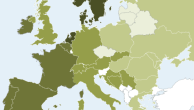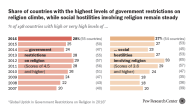This report uses data collected by Pew Research Center. To analyze gender differences in religious affiliation, it draws on estimates of religious composition in 192 countries and territories published in the Center’s April 2015 report, “The Future of World Religions: Population Growth Projections, 2010-2050.” The estimates are based on data from more than 2,500 censuses and surveys.
To compare men and women on other measures of religious commitment, the study uses survey data collected by Pew Research Center for the general population in 84 countries between 2008 and 2015. However, the number of countries varies for each measure because not all survey questions were asked in every country. Some of the data come from Pew Research Center’s regional studies of religious beliefs and practices. In other cases, the data come from the Center’s spring survey of Global Attitudes. For some countries, more than one survey is used in order to incorporate more measures than would be possible using a single survey. Additional details about these surveys are listed in the Methodology. Appendix C lists the sources used for each country in every part of this report.
Pew Research Center surveys have shown that, at least in the United States, religious commitment varies across age groups. This report, however, does not compare varying levels of commitment among people of different ages.57
Following conventional survey norms, respondents to surveys used in this report were not usually asked directly about their gender identity, whether they were interviewed face-to-face or by telephone. Rather, interviewers coded interviewees as male or female.58
When this report discusses Jewish populations in Israel and the United States, it is referring to Jews who identify as Jewish by religion, as opposed to those who identify as Jewish only by culture or ancestry and not by religion.
For more details on the research methods used in this study, see the Methodology.




